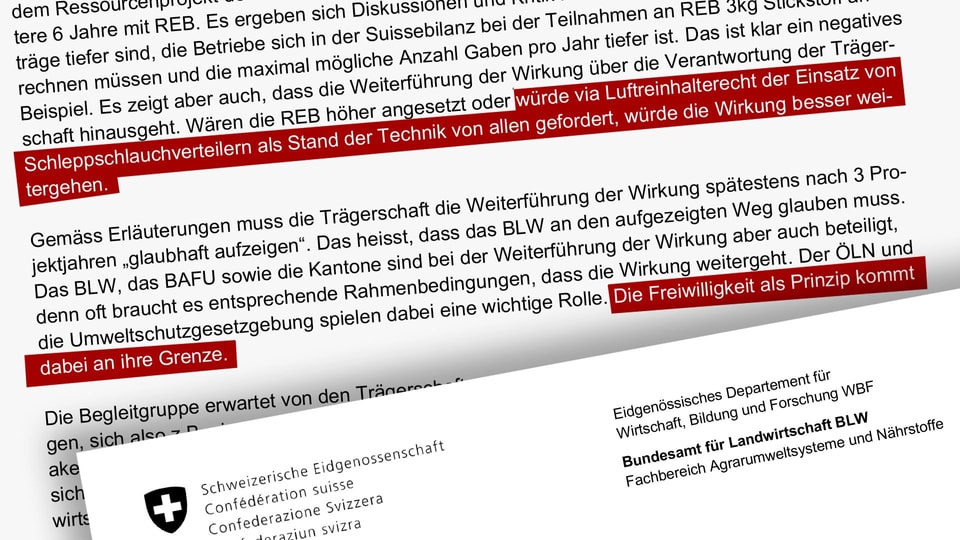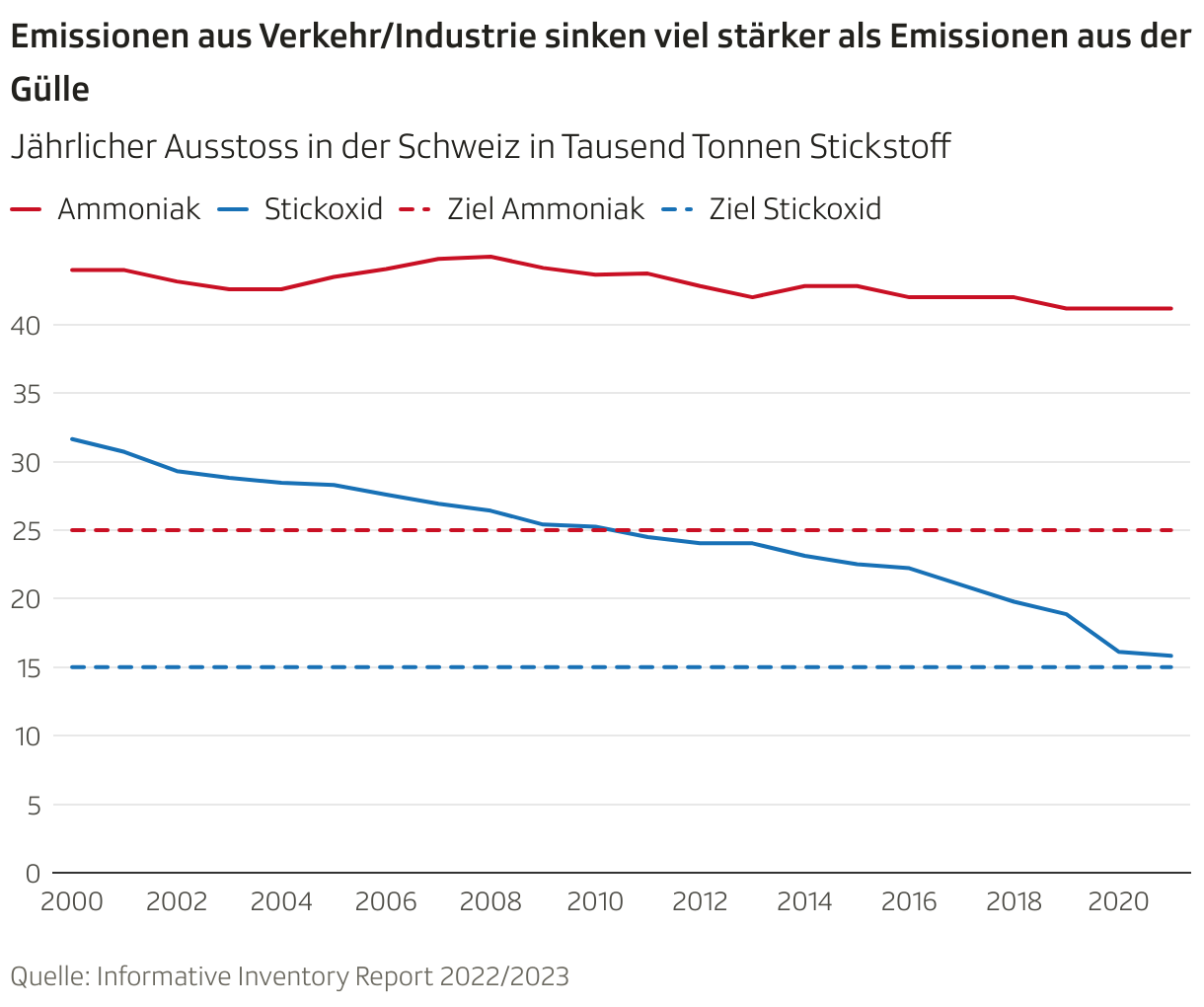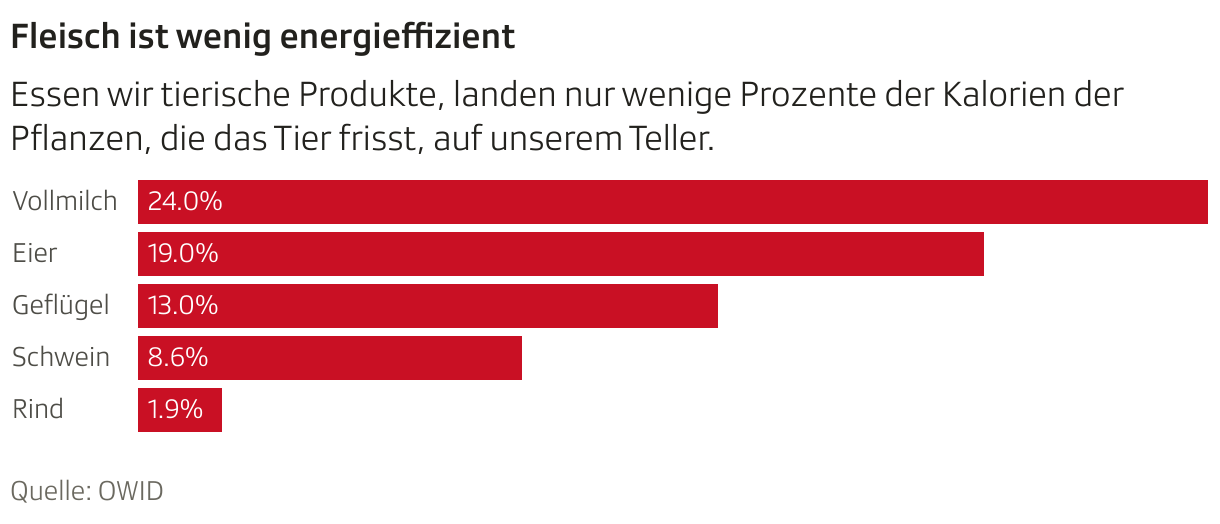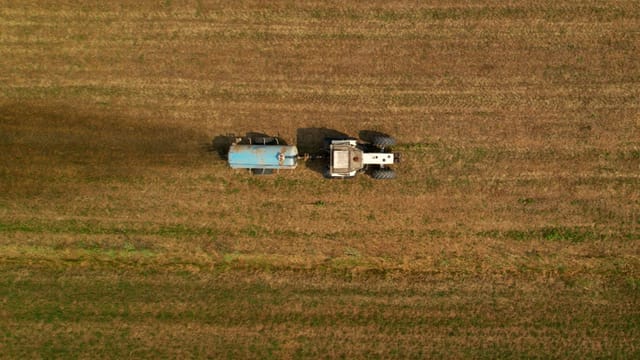In Swiss forests, emissions have been too high for 60 years, and in individual lakes for 40 years. The political measures against pollution cost Hundreds of millions of taxpayers’ money without solving the problem – and no one except nature bears the consequences.
Too much manure damages lakes, air, forests and groundwater
One place to highlight the environmental problems of Swiss meat production is the Lucerne Mittelland: In the area around Lake Baldegg, Sempach and Hallwil (AG) there has been a “pig valley” with animal farmers, feed mills, an insemination company and manure since the 1960s – and pig transporters and slaughterhouses emerged.
External costs of up to 2.5 billion francs annually
With intensive farming next to sensitive lakes, the pig industry’s annual turnover is estimated to be one billion, while environmental damage has been kept in check with technical measures for 40 years without being remedied. So far, taxpayers have paid around 130 million for the renovation of the three lakes.
Legend:
The renovation of Lake Baldegger, Lake Sempach and Hallwil has so far cost taxpayers around 130 million francs. This also includes aerating the lakes.
SRF
Overall, according to the Swiss Academy of Natural Sciences, agriculture causes up to 2.5 billion francs in external costs annually due to the harmful effects of ammonia, nitrogen oxides, nitrate and nitrous oxide.
What are politicians doing about it? A look at the example of ammonia from manure shows: Although an enormous amount of tax money flowed, very little was achieved.
Environmental goals missed since 1999
The Federal Council’s appeal sounds very topical: “In order for the air quality targets to be achieved, additional effective measures are necessary for ammonia (the main cause is agriculture).” But it’s from 1999.
Environment Minister Ruth Dreifuss demanded on behalf of the Federal Council: 40 to 50 percent fewer ammonia emissions than in 1995; That means around 23,000 tons per year. However, today it is still 41,000 tons annually – 44 percent too much. “Around 75 million are lost in the air every year!” says agroecology expert Franz Xaver Stadelmann. That’s how much the nitrogen content in artificial fertilizer costs.
Around 75 million francs are wasted in the air every year!
Nowadays everyone is referring to the 2008 environmental target of 25,000 tons of ammonia. But it is just as non-binding as the agricultural policy milestones with deadlines. No reduction target of the last 15 years has been achieved. There are no sanctions.
“Deeply dishonest,” says Hansueli Gujer, an agricultural expert at the Federal Office for the Environment (FOEN) at the time. When he confronted his colleague at the Federal Office of Agriculture (FOAG) in 2020 with the goals that had not been achieved, he laughed at him. “That was the cynicism of the system,” says Gujer.
Pressure only came with the rejected agricultural initiatives. Now for the first time there is a binding reduction target, even if only for nitrogen (70 percent comes from ammonia): The Federal Council wanted 20 percent less by 2030, Parliament watered it down to 15 percent.
How do you reduce ammonia emissions? The federal government primarily relies on the drag hose. He spreads animal manure close to the ground on the field. This means that around 30 percent less ammonia escapes into the air than with the wide spreader, which sprays the liquid manure in all directions.
The use of the drag hose was supported with subsidies from 2008-2021, and other emission-reducing measures such as covering open manure silos and nitrogen-reduced animal feed were subsidized from 2008-2019.
Research by SRF DOK shows: around 240 million francs in tax money were paid, but the environmental target was still far missed. Ammonia emissions from agriculture only fell by just under ten percent. Despite dozens of millions in taxes, they are still 40 percent too high.
Around 240 million in taxes for an environmental goal that has been largely missed
Participation in the subsidy projects was voluntary for farmers. They only used the drag hose on around a third of the filled area. The drag hose will not be mandatory throughout Switzerland until 2024. Surprisingly late.
Research by SRF DOK shows: The drag hose was already being sold in series in Switzerland in 1992. The technology has been up to date since 1996. In 2006, ten cantonal environmental offices demanded that the drag hose become mandatory. This means: Farmers should only receive direct payments if they use manure hoses.
At the time, the Federal Council did not want to hear anything about coercion. The rejection to the cantons came from the then Environment Minister Moritz Leuenberger. Instead, he made voluntary resource projects popular with the cantons. In this way, measures could be promoted in accordance with the “regional need for action”.
“Voluntariness as a principle is reaching its limits”
The resource projects have been in law since 2008. It’s actually about having farmers test a technical innovation. In the case of the drag hose, however, the same innovation was tested in 20 cantons for a total of eleven years – and subsidized by 80 percent by the federal government. So almost nationwide, but voluntary. The conference of cantonal environmental offices wrote: “The question is whether this change in the law makes any sense at all.”
A few years later, the euphoria in the Federal Office of Agriculture (BLW) had also dissipated: “Voluntariness as a principle is reaching its limits,” it says in a protocol from 2016. SRF DOK was able to demand this through the public information law.

Legend:
A protocol from the Federal Office of Agriculture shows: It was already clear in 2016 that a drag hose was required.
SRF
It must be assumed that the majority of the projects will not achieve the reduction targets set by the canton. In Thurgau it is clear that many farmers no longer use the drag hose to manure after the resource project has been completed. Conclusion: “If the use of dribble hose distributors were required of everyone via air pollution control law as the state of the art, the effect would continue to be better.” However, the drag hose requirement will not come until 2024, eight years after this determination.
In between, “resource efficiency contributions” were made from 2014 to 2021: subsidies for all farmers who voluntarily manured with the drag hose. In effect, a continuation of the resource projects, which are limited to six years, in order to keep the farmers in line.
86 million tax francs were distributed in the resource efficiency programs without a reduction target being set. Ammonia emissions barely fell any further. The Federal Audit Office criticized the efficiency contributions for the drag hose as “not very efficient”.
Federal officials as “farmers’ vicarious agents”
Chemist and environmental lawyer Hans Maurer criticizes “officially tolerated environmental pollution”. At the beginning of the 2000s, many FOAG officials were “farmers’ vicarious agents”. This is what three experts who were involved in the ammonia issue at the time said unanimously.
- Biophysicist Peter Künzler had already recommended compulsory drag hoses in a report prepared for the FOEN in 2005: “The voluntary resource programs were unnecessary”says the air hygiene expert. But the FOEN gave way to the FOAG.
- Hans Gygax, former chief official in the environmental office of the canton of Friborg and former president of the Air Hygiene Association: “The resource projects were the federal government’s political instrument to involve the farmers. The Swiss Farmers’ Association had been slowing down for a long time.”
- Roger Biedermann, former cantonal chemist and head of the federal government’s “Nitrogen Balance Project Group”: At the beginning of the 2000s, he wanted to enshrine a nitrogen reduction target in law. The proposal came to parliament in 2006. Agriculture Minister Doris Leuthard argued against it “for regulatory reasons” because the cantons are responsible for enforcement. Parliament sank the proposal. “20 years of bad agricultural policy”says Biedermann today. And no improvement in sight.
“The farmers are above the law”
Why do ammonia emissions from manure remain at a high level while those of nitrogen oxide have fallen sharply over the last 40 years? This is mainly due to the rapid introduction of the catalytic converter in the 1980s.
At that time, the debate about “forest dying” was on everyone’s lips, and the population’s fear was great. 75 percent of nitrogen oxides came from traffic and contributed to ozone formation. In addition to sick trees, there were fears for the health of small children. “Political resistance was therefore lowest when it came to air measures,” remembers Franz Xaver Stadelmann, then head of the Institute for Environmental Protection and Agriculture.
The Clean Air Act was introduced in 1986 and the catalytic converter in 1987. Switzerland played a leading role across Europe. The research on ammonia from manure is completely different. “It was unpopular even back then,” remembers Stadelmann. In 1986, the then director of the Federal Office of Agriculture, Jean-Claude Piot, even wanted to ban him from publishing about the negative effects of manure. “The farmers are above the law,” says former FOEN expert Hansueli Gujer matter-of-factly.
We would have to eat 70 percent less meat
In contrast to the catalyst, the environmental goal cannot be achieved with ammonia using technical measures alone. The only solution is a political taboo: reducing the number of animals. Experts such as Bernhard Wehrli, professor of aquatic chemistry, and biologist Sabine Braun, who has been studying the damage of ammonia in forests for 40 years, demand only half as many farm animals.
Technical measures alone are not enough, say other researchers who do not want to be named because they work with farmers on their projects.
But because the Federal Council does not want to start at the source and force the population to give up meat, it is approaching the issue through the back door: “Food instead of feed” is the magic word of the new climate strategy that was presented in September. More plants for human consumption instead of animal feed.
Today, around 60 percent of arable land is used to produce animal feed. For example, corn will now be grown for people instead of pigs. If we eat pork, we only get around 10 percent of the plant calories.
Ultimately, we as consumers are responsible: According to the agricultural research institute Agroscope, we would have to eat 70 percent less meat in order to have less impact on the environment. Specifically: A maximum of 45 grams of meat per day.




